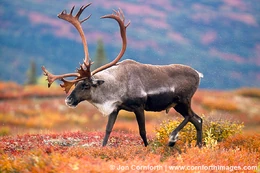
Male Caribou in Denali National Park, Alaska.
Caribou, also called reindeer, are found in northern regions of North America, Europe, Asia, and Greenland. As summer approaches, caribou herds head north in one of the world's great large-animal migrations. They may travel more than 600 miles (965 kilometers) along well trod annual routes. At the end of their journey, they spend the summer feeding on the abundant grasses and plants of the tundra. In these rich grounds, an adult caribou can eat 12 pounds (5 kilograms) of food each day. During migration, herds of cows (female caribou) leave several weeks before the males, who follow with yearling calves from the previous birthing season.
Caribou have large hooves that are useful tools for life in the harsh northlands. They are big enough to support the animal's bulk on snow and to paddle it efficiently through the water. The hoof's underside is hollowed out like a scoop and used for digging through the snow in search of food. Its sharp edges give the animal good purchase on rocks or ice. Caribou are the only deer in which male and females both have antlers—though only some females have them. Cows have one calf each year, which can stand after only a few minutes and move on with its mother by the next day.
Caribou mate in October and the gestation period is about 228–234 days. In May or June the calves are born. Males live 4 years less than the females whose maximum longevity is about 17 years. Females with a normal body size who have had sufficient summer nutrition, can begin breeding anytime between the ages of one to three years.When a female has undergone nutritional stress, it is possible for her to not reproduce for the year. Dominant males, those with larger body size and antler racks, inseminate more than one doe a season.
To calve, "females travel to isolated, relatively predator-free areas such as islands in lakes, peatlands, lakeshores, or tundra." As females select the habitat for the birth of their calves, they are more wary than males. Dugmore noted that in their seasonal migrations the herd follows a doe for that reason. Newborns weigh on average 6 kg (13 lb).
As the weather cools in the fall, barren-ground and Porcupine caribou would leave their summer grounds forming large herds and migrate south for the winter. They would start mating when large lakes were frozen over. Just prior to mating, the males of both caribou were in prime condition, fat and ready to battle for mates. Bulls at this time were more aggressive and they were usually alone. When the first snows fall each year, the caribou turn south and complete a migration that sees them travel as many as 1,600 miles (2,574 kilometers) each year. They spend the winter in more sheltered climes and survive by feeding on lichens. Caribou are traditionally vital to indigenous northern people throughout much of their range.